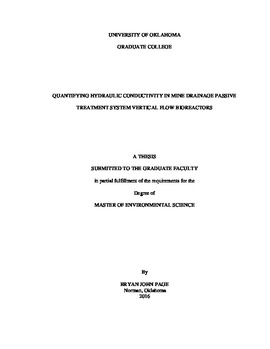| dc.contributor.advisor | Nairn, Robert W. | |
| dc.contributor.author | Page, Bryan J. | |
| dc.date.accessioned | 2016-12-16T18:26:22Z | |
| dc.date.available | 2016-12-16T18:26:22Z | |
| dc.date.issued | 2016-12 | |
| dc.identifier.uri | https://hdl.handle.net/11244/47069 | |
| dc.description.abstract | Heavy industrial mining has occurred in the United States for more than 100 years, and in many cases, has led to large-scale environmental degradation, especially from historical operations where mining occurred prior to environmental regulations. Many of these derelict or abandoned operations discharge abandoned mine drainage (AMD), which contains ecotoxic metal-contamination that impairs receiving stream water quality and negatively impacts local ecology. Passive treatment systems (PTS) are cost effective treatment technologies that are designed to use relatively little fossil fuels and natural physicochemical (e.g., limestone dissolution) and biological (e.g., bacterial sulfate reduction) processes for the treatment of AMD.
One of the key components of PTS are vertical flow bioreactors (VFBRs). VFBRs typically include waste organic materials as microbial substrates overlying rock drainage layers. They utilize the dissolution of limestone to generate alkalinity for neutralization of excess protons and promote sulfate-reducing bacteria for additional alkalinity generation and trace metal removal as sulfides. However, long-term operation and maintenance issues in PTS include decreased hydraulic conductivity in VFBRs. Decreased hydraulic conductivity leads to either water by-passing the cell or decreased treatment efficiencies. This research focused on quantifying the hydraulic conductivity and characterizing the organic layer in VFBRs of multiple passive treatment systems with the intention of developing plans for extending the lives of the treatment systems.
VFBRs at the Mayer Ranch, Hartshorne and Red Oak PTS were selected for this study. This research used four different methods to estimate hydraulic conductivity in VFBRs that have been in operation for 8-15 years. Hydraulic conductivity was compared against several different treatment media characteristics. The hydraulic conductivity measurements ranged from 9.93x10-3 to 1.74x10-5 cm/s. The comparison of the hydraulic conductivity and the treatment media characteristics indicated a trend that as particle density increased the hydraulic conductivity decreased. The comparison of the different methods did not yield one definitive method, but found that site variables dictated that certain methods may be more accurate or viable than others. The results helped to characterize the treatment media and quantified the hydraulic conductivity of the treatment media of VFBRs. | en_US |
| dc.language | en_US | en_US |
| dc.subject | Environmental Sciences. | en_US |
| dc.subject | Passive Treatment | en_US |
| dc.subject | Vertical Flow Bioreactors | en_US |
| dc.subject | Hydraulic Conductivity | en_US |
| dc.title | QUANTIFYING HYDRAULIC CONDUCTIVITY IN MINE DRAINAGE PASSIVE TREATMENT SYSTEM VERTICAL FLOW BIOREACTORS | en_US |
| dc.contributor.committeeMember | Miller, Gerald A. | |
| dc.contributor.committeeMember | Knox, Robert C. | |
| dc.date.manuscript | 2016-12 | |
| dc.thesis.degree | Master of Environmental Science | en_US |
| ou.group | College of Engineering::School of Civil Engineering and Environmental Science | en_US |
